Emissions of greenhouse gases down during the pandemic
Significant declines in the emissions of greenhouse gases were seen during 2020, the first year of the Covid-19-pandemic. In the Nordic region, total emissions were down by just over ten percent compared to 2019. The decline in the separate countries varied between 2.7 in Greenland and 15.9 percent in Iceland. In CO2 equivalents the decline in the region was largest in the Energy sector, and in percent in International aviation.
During the first year of the Covid-pandemic a large part of society shut down. This effected a lot of things, amongst them the emissions of greenhouse gases (GHGs) in the world. The Nordic region was no exception, total emissions were down by over ten percent in 2020 compared to the previous year.
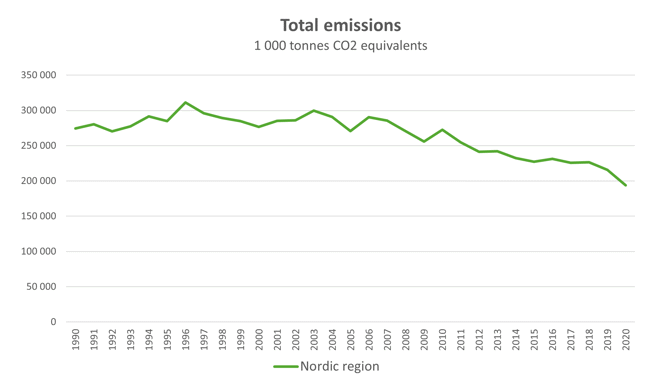
Source: Nordic Statistics Database, EMIS11: Greenhouse gases, national emissions in 1000 tonnes CO2 equivalents by reporting country, sector and time.
The trend has been downward for almost 20 years, but the decline in 2020 was larger than would have been expected under normal circumstances. The Figure below shows the change in total emissions compared to the previous year, in percent, for the Nordic region and the EU. In 2020 emissions in both the Nordic region and the EU as a whole was down by over ten percent. In the Nordic region the average yearly change since 1990 has been -1.05 percent and in the EU -1.22 percent.
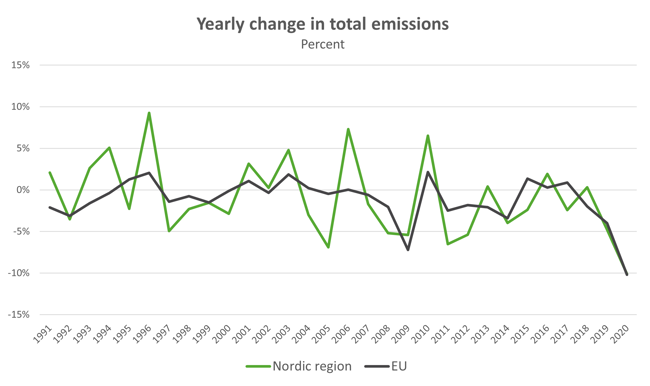
Source: Nordic Statistics Database, EMIS11: Greenhouse gases, national emissions in 1000 tonnes CO2 equivalents by reporting country, sector and time.
When analysed by sector, the Energy sector has the by far largest emissions. In the past ten years, the Energy sector has accounted for on average 68 percent of the total GHG emissions in the Nordic region. It is therefore also reasonable that this sector shows the largest reduction in emissions in terms of CO2 equivalents, 12 800 of the total decline of 21 800, or 59 percent.
In the International Energy Agency report “Global Energy Review: CO2 Emissions in 2020” [1] it is stated that global energy-related CO2 emissions fell by 5.8 percent in 2020, and that the decline in CO2 emissions from oil use in the transport sector accounted for well over 50 percent of this drop. No corresponding figure is available for the Nordic region, but it is reasonable to assume that a decline in the transport sector (excluding International aviation) had a large impact here as well.
A sector that is much smaller in emissions is International aviation, but this is where the largest relative decline is seen – the emissions from this sector dropped by 67 percent in the Nordic region. Travelling internationally was heavily restricted in all Nordic countries during the majority of 2020.
Other sectors and Indirect CO2 have been excluded from the Figure because of missing data from multiple countries.
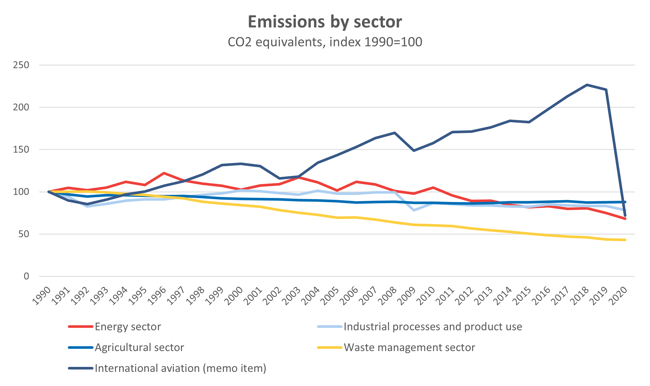
Source: Nordic Statistics Database, EMIS11: Greenhouse gases, national emissions in 1000 tonnes CO2 equivalents by reporting country, sector and time.
BY COUNTRY
The decline from 2019 to 2020 in the separate countries varied between 2.7 percent, in Greenland, and 15.9 percent, in Iceland.
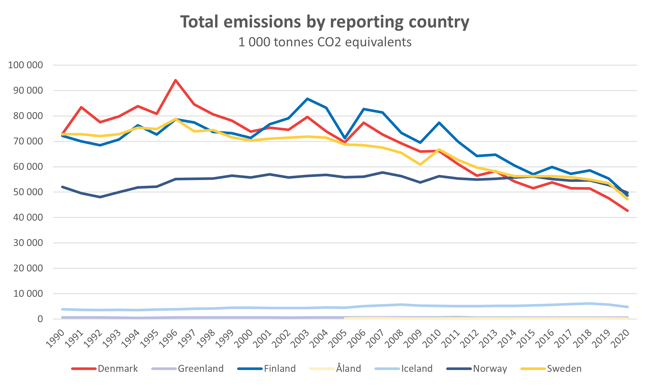
Source: Nordic Statistics Database, EMIS11: Greenhouse gases, national emissions in 1000 tonnes CO2 equivalents by reporting country, sector and time.
Worth noticing is that total emissions in Denmark, Finland, Norway and Sweden are almost equal today, despite the countries difference in population. This is mainly due to differences in use of fossile fuels and industrial sectors.
The figure below illustrates differences in sectors responsible for emissions. More detailed information on these differences can be found at the Nordic Energy website [2].
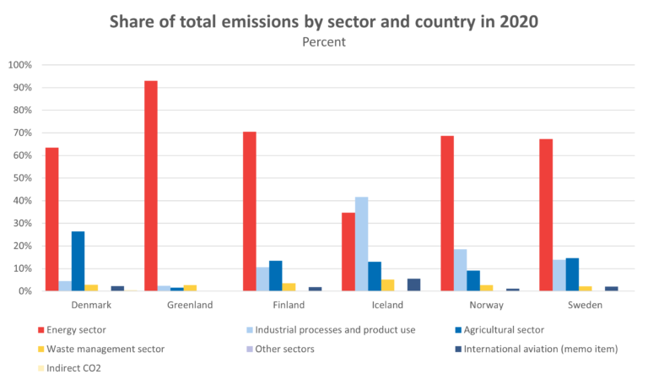
Source: Nordic Statistics Database, EMIS11: Greenhouse gases, national emissions in 1000 tonnes CO2 equivalents by reporting country, sector and time.
The Energy sector has the largest share of emissions in all countries except Iceland, where Industrial processes and product use is larger. In the same way, the decline in emissions, measured in CO2 equivalents, is greatest for the Energy sector in all countries with the exception for Iceland. Here the drop in emissions from International aviation accounted for the majority of the total drop.
International aviation accounts for a small share of emissions for most countries, one to two percent for Denmark, Finland, Norway and Sweden and six percent in Iceland in 2020. But the part that International aviation plays in the 2020 drop in emissions is large, between 26 percent in Finland and 78 percent in Iceland.
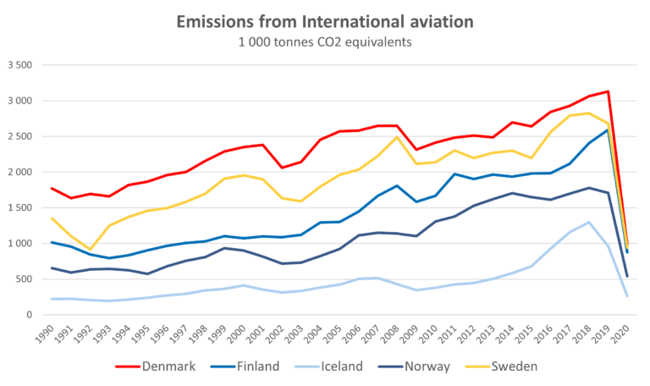
Source: Nordic Statistics Database, EMIS11: Greenhouse gases, national emissions in 1000 tonnes CO2 equivalents by reporting country, sector and time.
Please note that Faroe Islands has been excluded from the analysis completely, because there is no data available. The Nordic region is here therefore comprised of seven countries. Åland has data on total emissions but not per sector. Åland is however also included in the figures for Finland, so the values per sector for the Nordic region are complete.
[1] https://www.iea.org/articles/global-energy-review-co2-emissions-in-2020
[2] https://www.nordicenergy.org/figure/greenhouse-gas-emissions-per-capita/